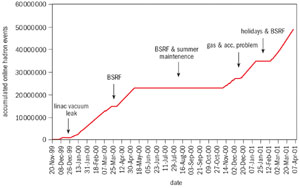
While plans to update the Beijing Electron-Positron Collider (BEPC) and the Beijing Spectro-meter (BESII) experiment go ahead, the BES experiment has completed its second highly successful run at the J/psi resonance this year.
The first run began in November 1999 and lasted until May 2000. The second lasted from December 2000 until May 2001. BES accumulated 24 million and 27 million J/psi events in the two running periods respectively, making a total of 51 million events (figure 1). This is the world’s largest sample of J/psi events produced from electron-positron annihilation. Previous large data samples of 6-8 million J/psi events were collected by MARKIII (SLAC, Stanford), DM2 (DCI, Orsay) and BES (Beijing) experiments. The new sample will allow the properties and decays of the J/psi to be studied with unprecedented precision.
The discovery in 1974 of the J/psi particle, composed of a charmed quark and antiquark, was crucial in establishing the quark model. In this model, almost all observed mesons and baryons can be described as composite objects made of quarks that are held together by the strong nuclear force. The theory that describes this is called quantum chromodynamics (QCD). In this theory, the carriers of the strong nuclear force are gluons and the quarks are held together by the exchange of gluons.
However, QCD also predicts the existence of exotic hadrons. These are glueballs, which are made up entirely of gluons, and hybrids, which contain both quarks and gluons. Masses of glueballs and hybrids are predicted by lattice QCD calculations and other theoretical models. Establishing the existence of exotic hadrons experimentally is very important in order to confirm QCD.

Many experiments have searched and some exotic hadron candidates have been reported, but they have not yet been confirmed to everyone’s satisfaction. J/psi decays are excellent places to search for these exotic particles.
During the latest BES run, the luminosity increased gradually. A peak BEBC luminosity of 5 ¥ 1030cm2/s was attained and a record number of 0.42 million J/psi events were accumulated in one day. After completion of the first round of reconstruction of all J/psi events, careful off-line calibration of the data shows that the BES detector performed well with a barrel time-of-flight resolution of 180 ps, energy loss rate resolution of 8% and a momentum resolution of 1.78%.
According to QCD, radiative decays of J/psi particles, where a photon is also produced in the decay, are regarded as an important process to search for glueballs. Physicists at BES have started to study radiative decays of J/psi particles, including those producing a pair of neutral kaons, a proton-antiproton pair and so on. Searches for possible 0++ and 2++ glueball candidates will be made. BES is carrying out detailed analyses on many different J/psi decays to determine the spin and parity of the final states.
The large J/psi sample will also allow many other studies. Hadronic decays of the J/psi provide a wealth of opportunities for searching for hybrids; studying light meson spectroscopy; observing excited baryonic states; measuring SU(3) mixing angles; and probing lepton flavour violation and CP violation.








